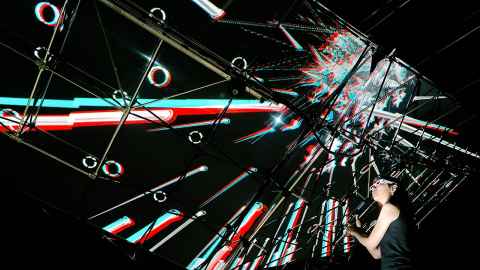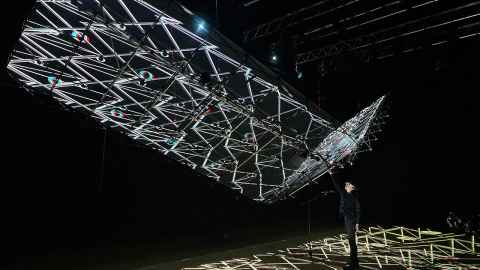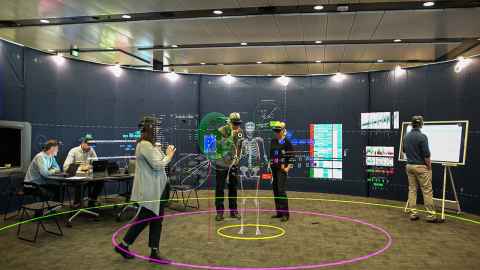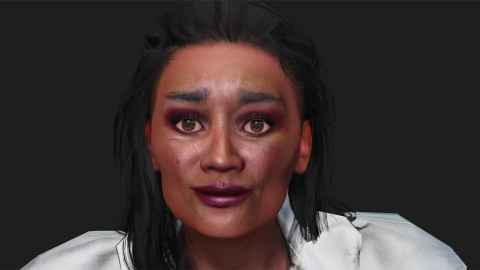Virtual, mixed and extended realities on show
13 June 2022
After two years of online exhibitions because of lockdown, Ars Electronica Garden Aotearoa is open to the public in a physical exhibition for the first time, in Wellington in June.

For the first time, Ars Electronica Garden Aotearoa is open to the public as a physical exhibition.
It's being held at Herenga Waka Victoria University of Wellington, and visitors will see and experience immersive, interactive, virtual and mixed realities created by researchers, designers, scientists and artists from across Aotearoa New Zealand, including from Waipapa Taumata Rau University of Auckland.
Ars Electronica is the world’s largest media festival and is held annually in Linz, Austria. It's an international festival that uses the digital revolution as a platform to explore cutting-edge technologies and their potential impact.
For the past three years, researchers from the arc/sec Lab in the School of Architecture and Planning at the University of Auckland and the Digital Architecture Research Alliance (DARA) at Victoria University of Wellington have partnered with Ars Electronica and UniServices, the University of Auckland’s research impact company, to present Garden Aotearoa.
The 2020 and 2021 Garden Aotearoa exhibitions were planned as a hybrid physical and online exhibition, but lockdowns prevented the physical exhibition going ahead. This is the first physical exhibition of Ars Electronica Garden Aotearoa and features around 15 installations as well as performances, demonstrations and talks.
Installations from the University of Auckland include LightSense, a collaboration between the arc/sec Lab, the Augmented Human Lab and the Empathic Computing Lab at the Auckland Bioengineering Institute (ABI), and the New Dexterity Group in the Faculty of Engineering.
In this, a large-scale kinetic lightweight structure (12m x 3m) is combined with holographic, digital animations, and an integrated AI system that has been trained with 60,000 poems to lead and sustain conversations with visitors. It then responds to the emotional tenor of the conversation by changing shape, immersing visitors in Pavilions of Love, Anger, Curiosity and Joy.

The XR Tumour Project meanwhile, immerses visitors in the data of a cancer patient in an interactive extended reality (XR) setting, an ‘arena’ that combines physical architecture with digital clinical information.
This project is a collaboration between the Faculty of Medical and Health Sciences, the Centre for eResearch and the arc/sec Lab at the University of Auckland. It began when a patient with inoperable cancer donated their tissue for research into the progression of their disease.
XR Tumour Project allows multiple users to interact with the 3D model of tumours simultaneously, and with a range of different types of information including genomics, scans, x-rays and biopsy information.
“The project is an exploration of how the evolution of cancer can be represented visually, by combining detailed genomic, pathological, spatial and temporal data – allowing multiple users to interact with the digital 3D model simultaneously,” says Associate Professor Uwe Rieger, who heads the arc/sec lab at the University.
“It is also about exploring the potential of an interactive tool that will let clinicians, physicians and patients visualise and discuss their disease and treatment.”

Also featured is Haptic HONGI, the latest iteration in a series of XR experiences co-designed by PhD candidate in Design, Mairi Gunn, multi-media artist and performer, Tania Remana (Ngāpuhi) and researchers in the Empathic Computing Lab at the ABI.
This project aims to bring Māori ‘to the table’ in a reimagined first encounter. Visitors are invited to join Mairi at the table and are then greeted by a pre-recorded volumetric video representation of Tania Remana which can be seen through a Hololens ll headset.
Through her volumetric avatar, Tania locks the visitor in a mutual gaze and greets them in a re-imagined, contemporary first encounter. She invites the visitor to join her in a hongi and visitors will feel one forehead pressed against another, a greeting between a virtual version of a real woman and a human, delivered via an actuator built into the visitors’ AR headset.
The installation is an exploration of technology, but more importantly, the potential of technology to break down cultural and social barriers, says Mairi.
“The development of Haptic HONGI has been an experimental and iterative process, but the intention was always for technology to play a bridging role across cultures, to encourage broader social discourse.”
The creative arts is the ideal discipline to test the boundaries of emerging technologies, but also explore its potential impact on our ecology, our culture, and on our societies, says Dr Rieger. This is point of festivals such as Ars Electronica festival.
“Ars Electronica allows new ideas to be presented, and for people to see and experience and explore what these new ideas and technologies can do. It’s important we do that.”
Ars Electronica Garden Aotearoa has been supported by Creative New Zealand.
Find out more about schedule of events at Ars Electronica Garden Aotearoa 2022, on 16-22 June at Herenga Waka Victoria University of Wellington.

Media contact
Margo White I Media adviser
Mob 021 926 408
Email margo.white@auckland.ac.nz